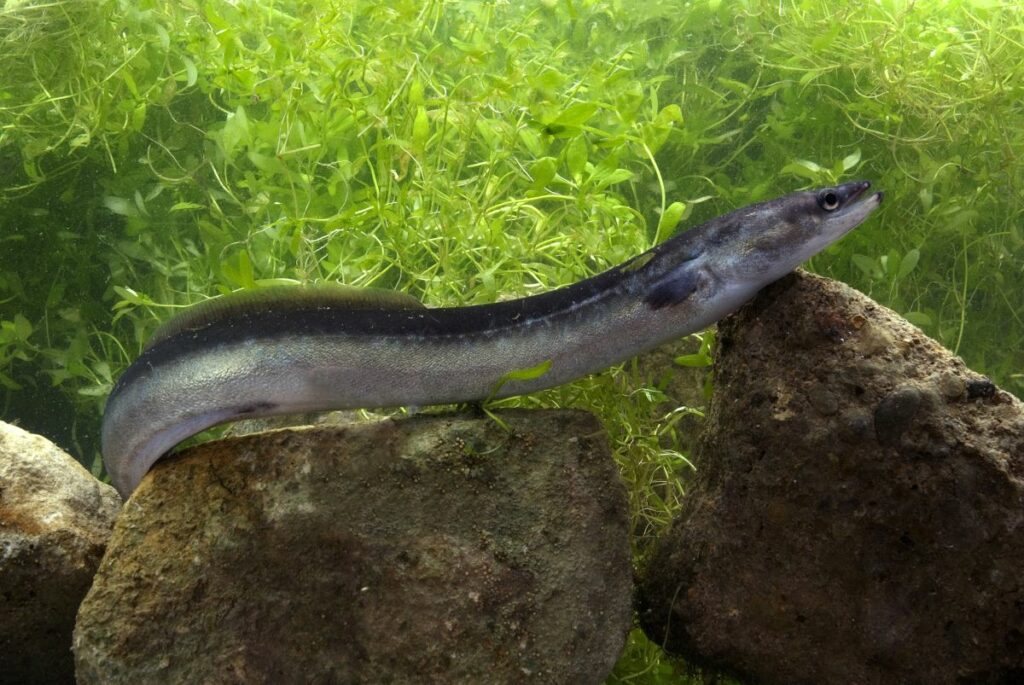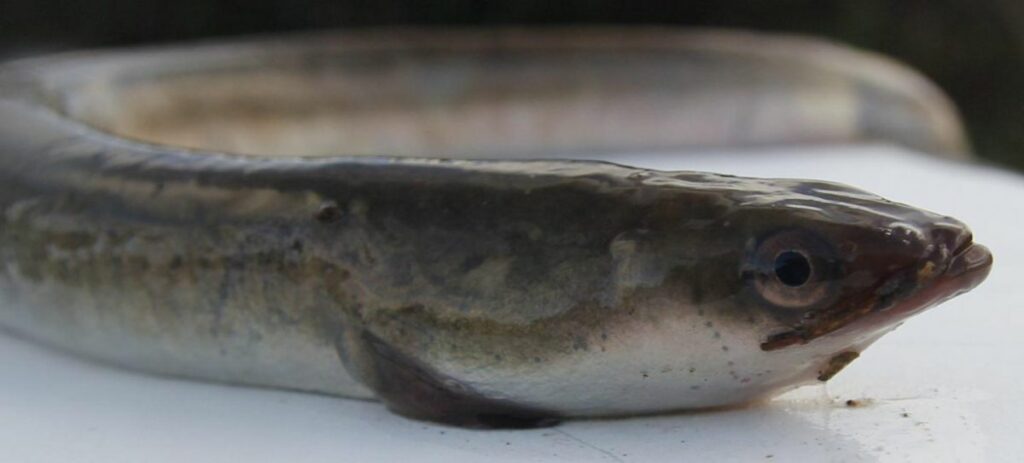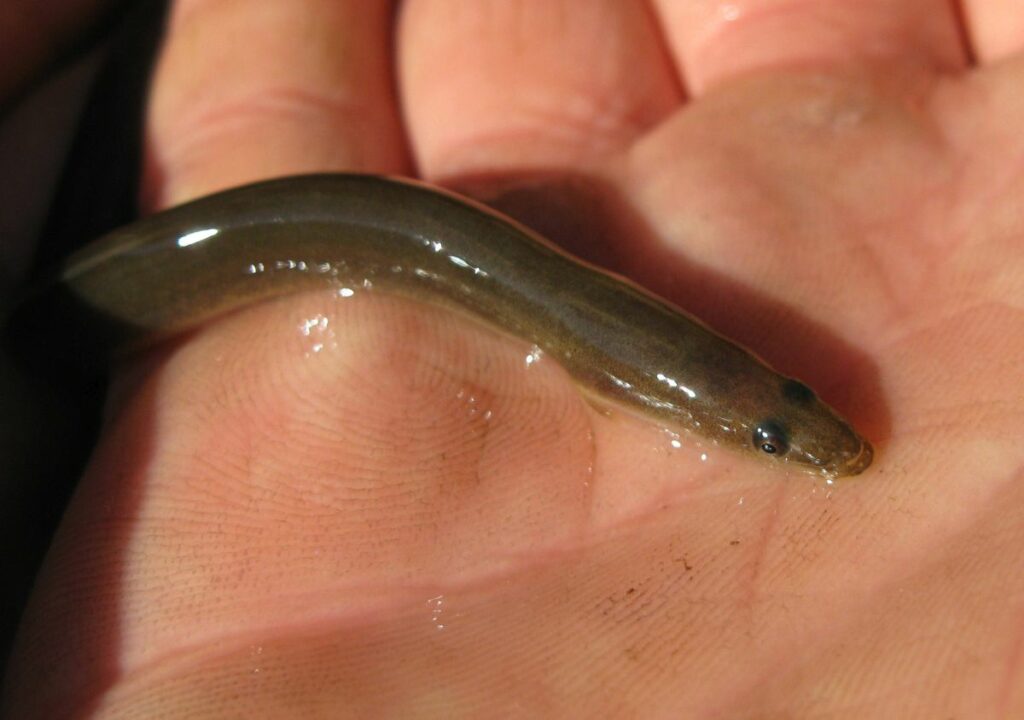European eels are long, snake-like fish found across waters near Europe and Africa. For much of history, their lives remained a mystery as they eluded researchers.

We now know that they spend most of their lives in freshwater, but return to the ocean to spawn. We know that they do this, but we still don’t know why.
What Is A European Eel?
European eels are long, cylindrical fish with one pair of pectoral fins. They lack pelvic fins. Like all true eels, their dorsal fins are continuous across the length of their back. The dorsal fin connects with the anal and caudal fins. Their lower jaw is slightly longer than their upper jaw.
They are large fish that grow to lengths of up to 52 in (132 cm). They can also weigh up to 14.5 lbs (6.6 kg). Females tend to be much larger than males.
European Eel Lifespan
Male European eels often live between 6-12 years. Females live longer, between 9-20 years.
Captive European eels don’t travel to the ocean to spawn. So, they seem to live much longer than their wild counterparts. The average lifespan of a captive European eel is 55 years. The oldest captive European eel ever recorded was 85 years old.
- Common Names: European eel, common eel, river eels, glass eel, weed eel, sing eel, yellow eel, silver eel
- Scientific Name: Anguilla anguilla
- Origin: Atlantic Ocean — spanning from Scandinavia to Morocco and the rivers of the North Atlantic, Mediterranean, and Baltic Seas. Also along the coast of Europe from the Black Sea to the White Sea.
- Length: 4.9 ft (1.5m)
Habitat
European eels live across a wide expanse of water. CABI describes their natural distribution area as:
“The natural distribution area of Anguilla anguilla in its freshwater habitat is located in the inland waters of the coastal areas of Europe and northern Africa, ranging from Murmansk near the North Cape of the Scandinavian Peninsula through the coastal areas of the Baltic Sea to the Atlantic coastal areas of Morocco. In the south it can be found in the coastal areas of the landmasses bordering the Mediterranean and the Black Sea.”
They are a shallow-water species, usually staying within 2,297 ft (700 m) of the water’s surface. They will stay near the bottom where they can hide in the substrate.
Behavior & Temperament

European eels are nocturnal. They hide within the muddy substrate of their habitat during the day, waiting to hunt at night.
During the winter months, European eels will go into hibernation.
These eels are also solitary species that become territorial around other eels. They do not seem to communicate with each other. They also navigate their environment through taste.
The University of Michigan Museum of Zoology says:
“European eels sense the environment using their sense of taste. They have been shown to locate necessary amino acids via chemotaxis. European eels also utilize olfaction, most probably for homing purposes. There is little if any documentation of social communication between eels.”
Breeding
All freshwater eels are catadromous. They spend most of their lives in freshwater but spawn in saltwater. They spend their lives in freshwater streams and rivers. When they become sexually mature, they are immediately ready to spawn.
The spawning grounds are often thousands of miles/kilometers away from the rivers. Yet, their drive to spawn is so intense that they will cross dams and small masses of land to get where they need to go.
Once there, hundreds or thousands of eels will spawn simultaneously. They spawn via external fertilization. A single female can release 2-10 million eggs into the water column. The male will then release his sperm into the water. If the two meet, the eggs become fertilized.
Shortly after spawning, all the adults die, making way for their offspring.
Life Cycle
When the eggs hatch, they produce transparent, leaf-shaped larvae. The larvae are “leptocephalus”.
They will immediately begin looking for fresher water. They will spend between seven months and three years drifting through the ocean. Their bodies are hard-wired to search for lower temperatures and salinity.
As they near coastal waters, the larvae transform into “glass” eels. They remain colorless, hence their name, but take on the typical cylindrical shape of eels.
As they continue to age, they will travel further up the river towards fresher water. They become “elvers” whose bodies are gray to brown in color.
Once they reach pure fresh water, they will have become “yellow” eels. Yellow eels are what most people recognize as “adult” eels, although they are not really adults. They are still juveniles at this stage and will remain “yellow” eels for about 20 years.
European eels spend the majority of their lives upstream where the water is freshest. Still, they will sometimes swim downstream when there is a new moon, or when there is flooding.
European eels only become adults once they are sexually mature. But, as soon as they become sexually mature, it is time to travel to the spawning grounds to die.
Adult eels are “silver” eels because their bodies take on a silvery metallic color. Their stomachs disintegrate and they don’t eat during their journey out to sea. Their eyes also become much larger, making it easier for them to see at night.
Diet
European eels are carnivores that feed primarily on invertebrates and fish. When food is scarce, they will eat dead fish as well. Reports have even seen them leaving the water to feed on slugs and worms on land during the winter months.
Smaller, less mature eels stick to smaller foods. Insect larvae, worms, mollusks, and crustaceans generally make up a juvenile’s diet.
Predators
Eels are a common food source for predators like larger eels, fish, and fish-eating birds. Cormorants and herons frequently hunt the eels.
The eels aren’t without their defenses, though. They spend most of their time within the muddy substrate and inside rocks. If captured, they produce a slime that makes it difficult for the predator to keep a grip on them.
European Eels Are Endangered

Due to human activity, the European eel populations are facing danger. The International Union for the Conservation of Nature (IUCN) lists European eels as “critically endangered”.
Estimates show the European eel populations may have dropped as low as 1% of what they once were.
The major threats to these eels include habitat loss, pollution, climate change, and predation. For instance, barriers, like dams and hydroelectric turbines, now block the eels’ migratory routes.
Also, despite their endangered status, some communities continue to eat them. Many are even exported to Asia for use as food.
The good news is that European eels are now protected in the European Union.
In 2009, the European Union added European eels to the list of species that are to be regulated and monitored. The Union’s management program aims to ensure at least 40% of silver eels make it back to sea to spawn. They aim to reduce fishing, improve habitats, and change the schedules of the hydroelectric turbines.
Conclusion
European eels, like all freshwater eels, spawn in the ocean before dying. Yet, they spend most of their lives in freshwater where they live near Europe and Africa.
There is still a lot that remains a mystery about these eels, but they are slowly unveiling their secrets.
FAQs
A eunuch eel refers to an eel that is sterile and cannot spawn. They don’t have the drive to return to the ocean. So, they remain in their freshwater habitat longer than those that spawn. It is likely that these eels live longer and grow larger than eels that spawn.
Some people theorize that eunuch eels are the monsters of legend. They argue that, since eunuch eels have no urge to spawn, they can grow to enormous sizes. For instance, some argue that the Loch Ness Monster may really be a large Eunuch eel.
But, there is no research to back this up. It is likely that eunuch eels live longer and grow larger than their counterparts. But, there is no evidence to suggest that they may grow to enormous sizes.
European eels are carnivores who feed on fish and crustaceans smaller than themselves. But, they are not aggressive and are not a danger to humans.
European eels are edible, and are a popular dish in some parts of Europe. The Dutch seem to have a particular fondness for them.
The blood of European eels is poisonous, but cooking destroys the poison.
